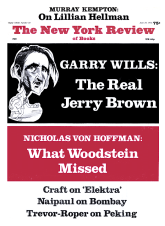In response to:
Was Alger Hiss Framed? from the April 1, 1976 issue
To the Editors:
May I offer a small footnote to Allen Weinstein’s article about Alger Hiss [NYR, April 1].
At one point Mr. Weinstein says:
Smith would have us believe that Chambers was able to enter the [State] Department and to stroll, unnoticed through its corridors, by using a government identification card he had acquired while working as a minor clerk on the National Research Project housed several blocks away.
Mr. Weinstein is obviously skeptical. It is certainly true that in post-Nixon (and post-Johnson) Washington this seems an unlikely thing. All those uniformed guards, plastic identification cards, security checkpoints etc!
But—in the 1930s when I was a reporter and often wandered about unnoticed through the corridors of the old State-War-Navy building where Cordell Hull’s State Department was housed (Foggy Bottom yet unthought, undreamed of) I recall no guards at the doors, no plastic identification cards, nothing to prevent myself, Chambers or anyone else from poking into just about any office he pleased (true, there were darkhued, silver-haired flunkies who lounged about reception offices, such as Mr. Hull’s and pleasant secretaries to direct you into inner offices). But in those pre-air-conditioned days for the most part one had only to open the great outer ventilation doors and march into an office. No one thought you might be up to any wrong.
There was one pleasant policeman who stood inside the door to the Press entrance of the White House (which was also the entrance for all business guests). He knew everyone who went in and out and while we did have cards issued not by the White House. Secret Service or any Security organization but by the White House Correspondents Association we did not, of course, ever have to show them.
Such a world seems impossible today and no doubt it was fearfully insecure. Yet, for all the opportunities for wandering Chambers perhaps the reality of security was more tangible.
Harrison E. Salisbury
The New York Times
New York
Allen Weinstein replies:
Mr. Salisbury apparently implies, in his recollections of the State Department during the 1930s, that my comments in the review on “security” there were unrealistic. John Chabot Smith argues that Chambers may have obtained all of the Hiss documents that turned up both on microfilm and in typed versions by wandering through the Department, filching them from the office where extra copies were periodically burned. Of course, I was not arguing that the State Department during the Thirties had “uniformed guards, plastic identification cards, security checkpoints etc!” As I wrote, “There is no question that State Department security procedures during the 1930s were extremely lax.” My point was simply to question Smith’s apparent assumption that Chambers could have moved about the Department “more freely than one of its own trusted employees.”
This Issue
June 10, 1976



